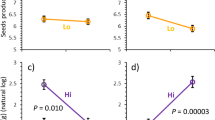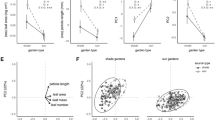Abstract
Naturally growing plants are able to plastically respond to myriad environmental challenges and opportunities. When confronted with multiple stresses, plants are expected to be able to prioritize their responses according to immediacy and predicted acuteness of these stresses. Here, we studied the interactive effects of competition and nutrient deprivation on growth responses of damaged Trifolium purpureum plants to salivary cues of a mammalian grazer. Salivary cues elicited marked growth responses in damaged but otherwise well-nourished and competition-free T. purpureum plants; however, this positive effect was annulled under Stipa capensis competition and was reversed under nutrient deficiency. The results suggest that the magnitude and direction of the effects of salivary cues on plant growth depend on an intricate prioritization of plant responses to prevailing and expected challenges and that T. purpureum plants perceive competition as a more acute stress than grazing. While herbivore saliva enables plants to reliably differentiate between herbivory and physical damage, the limited correlation between prevailing and future herbivory might reduce the informative value of salivary cues, rendering their effects weaker than those of prevalent competition and nutrient deficiency, whose continued detrimental effects are usually highly predictive. The results stress the importance of further studying the interactive effects of the acuteness and reliability of prevailing and anticipated stresses, and the informational content and adaptive value of environmental cues under various environmental circumstances.



Similar content being viewed by others
References
Aphalo PJ, Ballare CL (1995) On the importance of information-acquiring systems in plant–plant interactions. Funct Ecol 9:5–14
Ballare CL (2009) Illuminated behaviour: phytochrome as a key regulator of light foraging and plant anti-herbivore defence. Plant Cell Environ 32:713–725
Ballare CL, Scopel AL, Sanchez RA (1990) Far-red radiation reflected from adjacent leaves—an early signal of competition in plant canopies. Science 247:329–332
Bergman M (2002) Can saliva from moose, Alces alces, affect growth responses in the sallow, Salix caprea? Oikos 96:164–168
Boege K, Marquis RJ (2005) Facing herbivory as you grow up: the ontogeny of resistance in plants. Trends Ecol Evol 20:441–448
Bruins HJ (1990) The impact of man and climate on the central Negev and northeastern Sinai deserts during the Late Holocene. In: Bottema S, Entjes-Nieborg G, Van Zeist W (eds) Man’s role in the shaping of the Eastern Mediterranean Landscape. Balkema, Rotterdam, pp 87–99
Coley PD, Barone JA (1996) Herbivory and plant defenses in tropical forests. Annu Rev Ecol Syst 27:305–335
Detling JK, Dyer MI, Proctergregg C, Winn DT (1980) Plant–herbivore interactions—examination of potential effects of bison saliva on regrowth of Bouteloua gracilis (Hbk) Lag. Oecologia 45:26–31
Detling JK, Ross CW, Walmsley MH, Hilbert DW, Bonilla CA, Dyer MI (1981) Examination of North-American bison saliva for potential plant-growth regulators. J Chem Ecol 7:239–246
DeWitt TJ, Sih A, Wilson DS (1998) Costs and limits of phenotypic plasticity. Trends Ecol Evol 13:77–81
Diggle PK (2002) A developmental morphologist’s perspective on plasticity. Evol Ecol 16:267–283
Fan WH, Cui WT, Li XF, Chen SY, Liu GS, Shen SH (2011) Proteomics analysis of rice seedling responses to ovine saliva. J Plant Physiol 168:500–509
Florig HK, Morgan MG, Morgan KM, Jenni KE, Fischhoff B, Fischbeck PS, DeKay ML (2001) A deliberative method for ranking risks (I): overview and test bed development. Risk Anal 21:913–921
Forde B, Zhang HM (1998) Nitrate and root branching. Trends Plant Sci 3:204–205
Givnish TJ (2002) Ecological constraints on the evolution of plasticity in plants. Evol Ecol 16:213–242
Goldberg DE, Barton AM (1992) Patterns and consequences of interspecific competition in natural communities—a review of field experiments with plants. Am Nat 139:771–801
Goldshleger N, Ben-Dor E, Chudnovsky A, Agassi M (2009) Soil reflectance as a generic tool for assessing infiltration rate induced by structural crust for heterogeneous soils. Eur J Soil Sci 60:1038–1051
Halpern SL, Adler LS, Wink M (2010) Leaf herbivory and drought stress affect floral attractive and defensive traits in Nicotiana quadrivalvis. Oecologia 163:961–971
Heil M, Karban R (2010) Explaining evolution of plant communication by airborne signals. Trends Ecol Evol 25:137–144
Heil M, Walters DR (2009) Ecological consequences of plant defence signalling. plant innate immunity. Academic Press, London, pp 667–716
Heil M, Hilpert A, Kaiser W, Linsenmair KE (2000) Reduced growth and seed set following chemical induction of pathogen defence: does systemic acquired resistance (SAR) incur allocation costs? J Ecol 88:645–654
Hinman VF, Davidson EH (2007) Evolutionary plasticity of developmental gene regulatory network architecture. Proc Natl Acad Sci USA 104:19404–19409
Howe GA, Jander G (2008) Plant immunity to insect herbivores. Annu Rev Plant Biol 59:41–66
Karban R, Adler FR (1996) Induced resistance to herbivores and the information content of early season attack. Oecologia 107:379–385
Karban R, Agrawal AA, Thaler JS, Adler LS (1999) Induced plant responses and information content about risk of herbivory. Trends Ecol Evol 14:443–447
Keurentjes JJB, Angenent GC, Dicke M, Santos VAPMD, Molenaar J, van der Putten WH, de Ruiter PC, Struik PC, Thomma BPHJ (2011) Redefining plant systems biology: from cell to ecosystem. Trends Plant Sci 16:183–190
Korth KL, Dixon RA (1997) Evidence for chewing insect-specific molecular events distinct from a general wound response in leaves. Plant Physiol 115:1299–1305
Landau S, Perevolotsky A, Carasso Y, Rattner D (1995) Goat husbandry and production systems in Israel. EAAP Publication; Goat production systems in the Mediterranean. Wageningen Pers {a}, pp. 136–159
Long SP, Humphries S, Falkowski PG (1994) Photoinhibition of photosynthesis in nature. Annu Rev Plant Physiol Plant Mol Biol 45:633–662
Luikart G, Gielly L, Excoffier L, Vigne JD, Bouvet J, Taberlet P (2001) Multiple maternal origins and weak phylogeographic structure in domestic goats. Proc Natl Acad Sci USA 98:5927–5932
McNaughton SJ (1985) Interactive regulation of grass yield and chemical properties by defoliation, a salivary chemical, and inorganic nutrition. Oecologia 65:478–486
Moreno JE, Tao Y, Chory J, Ballare CL (2009) Ecological modulation of plant defense via phytochrome control of jasmonate sensitivity. Proc Natl Acad Sci USA 106:4935–4940
Nilsson P, Tuomi J, Astrom M (1996) Bud dormancy as a bet-hedging strategy. Am Nat 147:269–281
Novoplansky A (1991) Developmental responses of portulaca seedlings to conflicting spectral signals. Oecologia 88:138–140
Novoplansky A (1996) Developmental responses of individual Onobrychis plants to spatial heterogeneity. Vegetatio 127:31–39
Novoplansky A (2009) Picking battles wisely: plant behaviour under competition. Plant Cell Environ 32:726–741
Rooke T (2003) Growth responses of a woody species to clipping and goat saliva. Afr J Ecol 41:324–328
Schlichting CD, Pigliucci M (1998) Phenotypic evolution: a reaction norm perspective. Sinauer Associates, Sunderland
Shemesh H, Arbiv A, Gersani M, Ovadia O, Novoplansky A (2010) The effects of nutrient dynamics on root patch choice. PLoS One 5:e10824
Smith H (1982) Light quality, photoperception, and plant strategy. Annu Rev Plant Physiol Plant Mol Biol 33:481–518
Stewart MG (2001) Reliability-based assessment of ageing bridges using risk ranking and life cycle cost decision analyses. Reliab Eng Syst Saf 74:263–273
Stowe KA, Marquis RJ, Hochwender CG, Simms EL (2000) The evolutionary ecology of tolerance to consumer damage. Annu Rev Ecol Syst 31:565–595
Teng X, Ba L, Wang DL, Wang L, Liu JS (2010) Growth responses of Leymus chinensis (Trin.) Tzvelev to sheep saliva after defoliation. Rangel J 32:419–426
Thivierge K, Prado A, Driscoll BT, Bonneil E, Thibault P, Bede JC (2010) Caterpillar- and salivary-specific modification of plant proteins. J Proteome Res 9:5887–5895
Tiffin P (2000) Mechanisms of tolerance to herbivore damage: what do we know? Evol Ecol 14:523–536
Watson MA, Geber MA, Jones CS (1995) Ontogenic contingency and the expression of plant plasticity. Trends Ecol Evol 10:474–475
Weinig C (2000) Plasticity versus canalization: population differences in the timing of shade-avoidance responses. Evolution 54:441–451
Wu J, Baldwin IT (2010) New insights into plant responses to the attack from insect herbivores. Annu Rev Genet 44:1–24
Zhang Z, Wang SP, Jiang GM, Patton B, Nyren P (2007) Responses of Artemisia frigida Willd. (Compositae) and Leymus chinensis (Trin.) Tzvel. (Poaceae) to sheep saliva. J Arid Environ 70:111–119
Acknowledgments
The authors wish to thank Iara Gazzera Sandomirsky, Hagit Yahel, Asa Baumer Asahel Raveh, Yoav Bartan, Miranda Shemesh, Michal Gruntman, Chiemi Shirata, Yonat Mordoch, and C.A., for their technical assistance, and Halil and Ibrahim El-Azazme for their assistance with collecting the goat saliva. The study was supported in part by a research grant from the Israel Science Foundation to A.N. This is publication no. 746 of the Mitrani Department of Desert Ecology.
Author information
Authors and Affiliations
Corresponding author
Electronic supplementary material
Below is the link to the electronic supplementary material.
Rights and permissions
About this article
Cite this article
Shemesh, H., Ovadia, O. & Novoplansky, A. Prioritized contingencies: context-dependent regeneratory effects of grazer saliva. Plant Ecol 213, 167–174 (2012). https://doi.org/10.1007/s11258-011-9968-1
Received:
Accepted:
Published:
Issue Date:
DOI: https://doi.org/10.1007/s11258-011-9968-1




